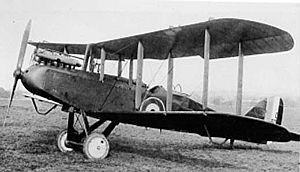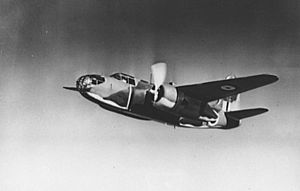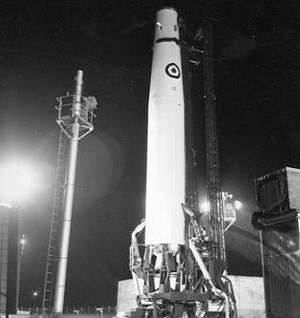No. 107 Squadron RAF facts for kids
Quick facts for kids No. 107 Squadron RAF |
|
|---|---|
| Active | 8 Oct 1917 – 30 Jun 1919 6 Aug 1936 – 4 Oct 1948 22 Jul 1959 – 10 Jul 1963 |
| Country | |
| Branch | |
| Nickname(s) | Lowestoft's 'own' Squadron |
| Motto(s) | French: Nous y serons ("We shall be there") |
| Commanders | |
| Notable commanders |
Basil Embry Ivor Broom |
| Insignia | |
| Squadron Badge heraldry | A double-headed eagle displayed gorged with a collar of Fleur de Lys. The double-headed eagle is one of the supporters from the armorial bearings of Salisbury, in which district the squadron was formed. The collar of fleur-de-lys was introduced in reference to service in France in the First World War during a period when the unit was attached to the French Army. The motto is said to have been derived from the squadron magazine produced in the First World War and entitled The Objective ('107' Squadron Always Gets There). |
| Squadron Codes | 107 (Aug 1936 – Oct 1938) BZ (Oct 1938 – Sep 1939) OM (Sep 1939 – Oct 1948) |
No. 107 Squadron RAF was a special flying unit of the Royal Air Force (RAF). It was first formed as a bomber unit during World War I. Later, it was brought back into action during World War II. It even played a part in the Cold War using large Thor missiles.
Contents
History of No. 107 Squadron
Forming in World War I
No. 107 Squadron started on October 8, 1917, at RAF Catterick. It was meant to be a day bomber unit. However, it didn't get its planes until May 15, 1918. These planes were called Airco DH.9s.
The squadron then moved to the Western Front in France on June 3, 1918. They began flying missions from a place called Drionville. Their main jobs were to attack enemy airfields, supply areas, and communication lines. They kept doing this until the war ended.
One of their most successful attacks was on July 21, 1918, at Saponay. They hit a huge ammunition dump there. The explosions and fires could be seen all night from their airfield, 20 miles away! The squadron returned to England in March 1919 and was officially closed down on June 30, 1919.
Reforming for World War II
No. 107 Squadron was started again on August 10, 1936, at RAF Andover. This time, it was a light bomber squadron. They first used Hawker Hind planes. Then, they got Blenheim Mk.Is in August 1938, and later Blenheim Mk.IVs in May 1939.
On September 4, 1939, the day after war was declared, No. 107 Squadron took part in the RAF's first bombing raid of World War II. Five of their planes, along with planes from No. 110 Squadron, attacked German ships in Wilhelmshaven. The mission was tough. Only one plane returned, and it still had its bombs.
One of their planes crashed into the German ship Emden, causing some damage and hurting sailors. The first British prisoner of war in World War II was Sergeant George Booth from 107 Squadron. His plane was shot down during this raid.
In April 1940, the squadron attacked German forces invading Norway. They also attacked enemy groups and supply lines during the invasion of France in May 1940. After the Dunkirk evacuation, they started attacking invasion barges and ships in the English Channel.
During one of these attacks, their new leader, Wing Commander Basil Embry, was shot down. He had taught the squadron to fly in tight groups for safety. He later escaped captivity, and his amazing story became a book!
Helping Coastal Command
Between March and May 1941, the squadron helped RAF Coastal Command. They were based at RAF Leuchars. Their jobs included attacking ships, protecting convoys, searching for submarines, and bombing enemy airfields and harbors. These missions were very dangerous. The squadron lost two commanding officers during this time.
Missions in Malta
After returning to RAF Bomber Command, the squadron continued its low-level daylight raids. In August 1941, their planes and pilots were sent to Malta. From Malta, they flew missions against enemy ships that were moving supplies between Italy, Sicily, and North Africa.
However, the German and Italian air forces made the air defense of Sicily much stronger. They also started bombing Malta's airfields day and night. Because of this, the squadron's air group was pulled out and closed down in Malta on January 12, 1942.
The squadron had suffered huge losses in Malta. About 90% of their crews were killed! At one point, a sergeant named I. G. Broom was in charge of the squadron. He later became a very important officer, Air Marshal Sir Ivor Broom.
New Planes: Bostons and Mosquitoes
While the air group was in Malta, the rest of the squadron stayed in England. On January 5, 1942, they received Douglas Boston training planes and new crews. They started learning to fly these new aircraft.
The squadron began flying daylight missions again in March 1942. One of their most famous missions with the Boston was called Operation Oyster. This was a daylight raid against the Philips factory in Eindhoven, Netherlands.
The squadron used the Boston until February 1944. Then, they switched to Mosquito Mk.VIs planes. With these, they started flying "night intruder" missions, attacking enemy targets at night. In November, the squadron moved to Europe, flying from Cambrai and later from Melsbroek.
They continued these night missions until the war ended. After the war, they stayed in Germany as part of the British Air Forces of Occupation. The squadron was closed down on October 4, 1948, and its role was taken over by No. 11 Squadron RAF.
Using Thor Missiles
In the late 1950s, Thor Intermediate Range Ballistic Missiles were used in the UK. Each missile squadron was supposed to control three launch sites. In September 1958, 107 Squadron started as part of the first RAF Thor missile unit, No. 77 Squadron RAF. They were based at RAF Tuddenham.
By June 1959, these groups became full squadrons. On July 22, 1959, the group at Tuddenham was officially named No. 107(SM) Squadron RAF. This made No. 107 Squadron one of twenty RAF squadrons to use the Thor missile.
However, this new version of No. 107 Squadron didn't last long. Newer, longer-range missiles (called ICBMs) were being developed, making the Thor missiles less important. In 1962, the government announced that the Thor missiles would be removed. So, the squadron was closed down again at Tuddenham on July 10, 1963.
Aircraft and Missiles Used
| From | To | Type | Version |
|---|---|---|---|
| May 1918 | Jun 1919 | Airco DH.9 | |
| Sep 1936 | Sep 1938 | Hawker Hind | Mk.I |
| Aug 1938 | May 1939 | Bristol Blenheim | Mk.I |
| May 1939 | Jan 1942 | Bristol Blenheim | Mk.IV |
| Jan 1942 | Feb 1944 | Douglas Boston | Mks.III, IIIa |
| Feb 1944 | Sep 1948 | De Havilland Mosquito | Mk.VIb |
| Jul 1959 | Jul 1963 | Thor Intermediate Range Ballistic Missile | SM.75 |
Commanding Officers
| From | To | Name |
|---|---|---|
| May 1918 | September 1918 | Major J. R. Howett |
| September 1918 | June 1919 | Major H. Gordon Dean |
| 25 September 1936 | 24 October 1937 | F/Lt. Ernest Alton Healy |
| October 1937 | June 1939 | S/Ldr. V. Q. Blackden |
| June 1939 | August 1939 | S/Ldr. Bear |
| August 1939 | September 1939 | W/Cdr. E. F. Haylock |
| September 1939 | May 1940 | W/Cdr. B. E. Embry |
| May 1940 | September 1940 | W/Cdr. L. R. Stokes |
| September 1940 | January 1941 | W/Cdr. J. W. Duggan |
| January 1941 | April 1941 | W/Cdr. W. E. Cameron |
| April 1941 | May 1941 | W/Cdr. Birch |
| May 1941 | July 1941 | W/Cdr. L. V. E. Petley |
| July 1941 | July 1941 | W/Cdr. Booth |
| July 1941 | October 1941 | W/Cdr. Harte |
| October 1941 | December 1941 | Sgt. I. G. Broom (acting) |
| December 1941 | January 1942 | W/Cdr. Dunlevie |
| January 1942 | September 1942 | W/Cdr. L. H. Lynn |
| September 1942 | December 1942 | W/Cdr. P. H. Dutton |
| December 1942 | February 1943 | W/Cdr. A. C. P. Carver |
| February 1943 | April 1943 | W/Cdr. I. J. Spencer |
| April 1943 | October 1943 | W/Cdr. R. G. England |
| November 1943 | July 1944 | W/Cdr. M. E. Pollard |
| July 1944 | April 1945 | W/Cdr. W. J. Scott |
| April 1945 | July 1946 | W/Cdr. W. C. Maher |
| August 1946 | December 1946 | W/Cdr. D. P. Hanafin |
| December 1946 | June 1947 | W/Cdr. B. Kemp |
| June 1947 | October 1948 | W/Cdr. Banning Lover |
| July 1959 | January 1961 | S/Ldr. R. P. Flood |
| January 1961 | July 1963 | S/Ldr. H. G. Norton |
See also





